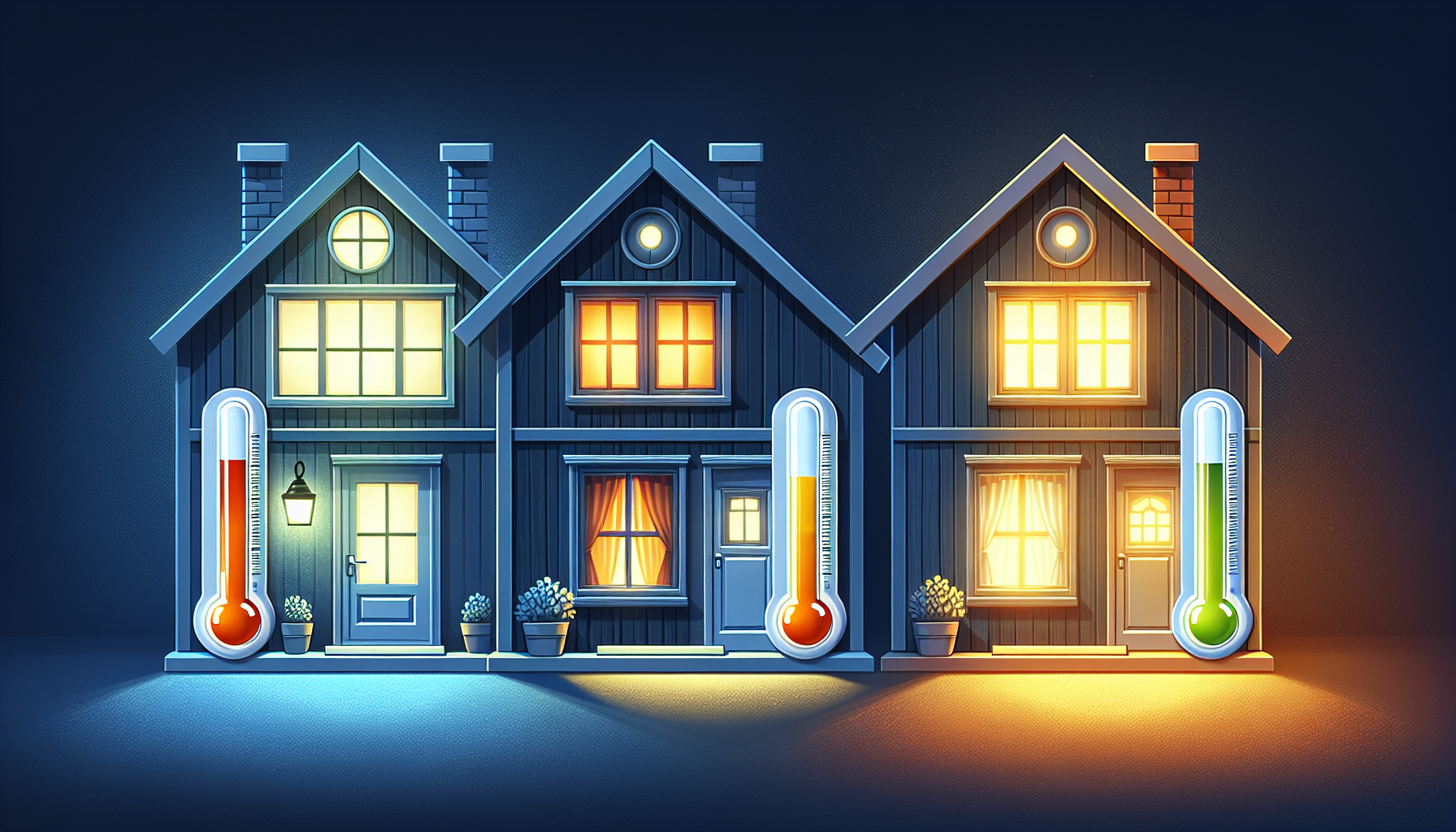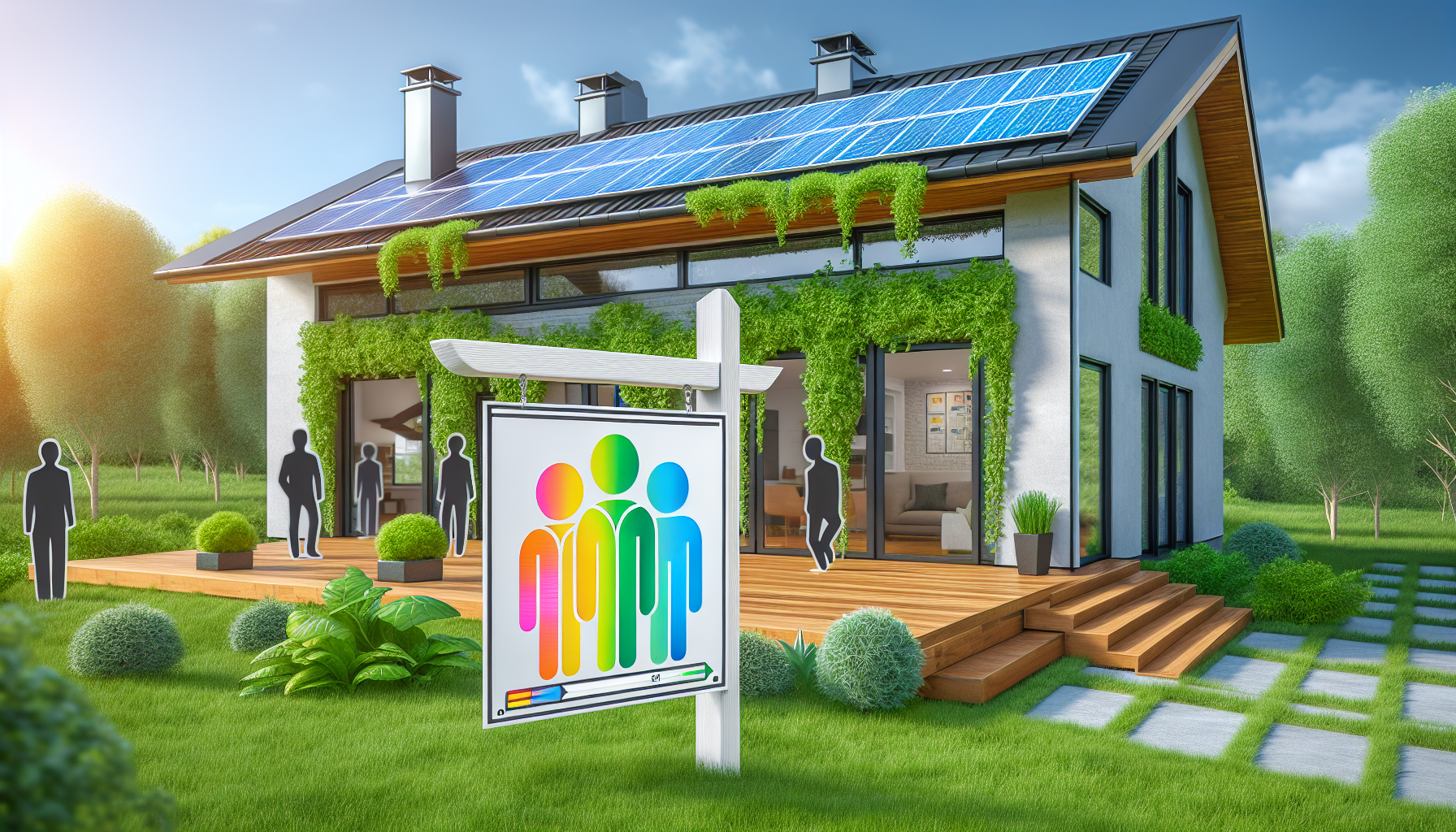Unlocking the Benefits of Energy Efficient Windows and Doors for a Greener Home
Why switch to the benefits of energy efficient windows and doors? Not only could you save money on energy bills, but you’ll also enhance your home’s comfort and its value. This article sheds light on the essential benefits of energy efficient upgrades, without diving too deep into the technical jargon or hard-selling unnecessary features.
Key Takeaways
-
Energy-efficient windows and doors are designed to minimize heat transfer, lower energy consumption, and provide improved comfort, potentially reducing heating and cooling energy bills by up to 40%.
-
Investing in energy-efficient windows and doors offers long-term financial benefits through savings on energy bills and by potentially reducing home’s carbon emissions by up to 15%, while also supporting job creation in the clean energy sector.
-
Energy-efficient windows and doors can increase a home’s value for prospective buyers, and various incentives and rebates from government entities and utility companies can offset installation costs.
Understanding Energy Efficient Windows and Doors

As implied by their name, energy-efficient windows and doors are specifically designed to lower heat transfer, cut down on energy usage, and boost the overall comfort of your home. This means they help in achieving the same task with reduced energy consumption, such as maintaining indoor temperature. Ultimately, they promote energy efficiency in residential properties.
These windows and doors aid passive cooling in homes by reducing heat gains and losses. This means they help in maintaining a comfortable temperature in your home without the need for constant use of heating and cooling systems. Installing these windows and doors can lead to energy savings and a reduced carbon footprint.
Features of Energy Efficient Windows
Distinct features of energy-efficient windows include double or triple glazing, low-emissivity coatings, and proper sealing. Double glazing refers to a window construction featuring two glass panes separated by a gap. This design effectively minimizes heat loss or gain, offering up to 30% improvement in energy efficiency compared to single-glazed windows.
Low-emissivity coatings, by reducing the amount of ultraviolet and infrared light passing through the glass, decrease heat transfer and enhance window energy efficiency.
Proper sealing is another key feature. Without it, even the best-designed window can allow drafts, cold spots, and air leakage, thereby reducing its energy efficiency. Proper sealing ensures that your windows perform at their best, contributing to the goal of achieving net zero emissions in residential buildings.
Types of Energy Efficient Doors
Similar to windows, doors are crucial in maintaining your home’s energy efficiency. Energy-efficient doors are typically made from materials with high insulation properties, such as fiberglass, steel, or wood with a foam core. These materials help in enhancing insulation, reducing the energy required for heating and cooling, and ultimately helping homeowners save money on energy bills.
The various types of energy-efficient doors offered in the market include:
-
Storm doors
-
Fiberglass exterior doors
-
Vinyl doors
-
Insulated steel doors
-
Insulated uPVC doors
-
Wooden doors
-
Insulated composite doors
Each of these doors, along with other energy-efficient appliances, can significantly improve energy efficiency in a home’s overall performance.
The Impact on Energy Bills

As one might expect, installing energy-efficient windows and doors can greatly affect your energy bills. By minimizing energy consumption and enhancing overall comfort, these upgrades not only help homeowners save money but also reduce the reliance on fossil fuels for heating and cooling.
Installing these windows and doors can lead to a significant reduction in heating and cooling expenses, resulting in substantial long-term energy bill savings. In fact, these installations have the potential to save up to 13% on heating energy bills.
Heating and Cooling Costs
In terms of heating and cooling costs, energy-efficient windows and doors can provide considerable savings. These windows and doors help maintain a comfortable indoor temperature by decreasing the reliance on heating and cooling systems, including air conditioners.
In fact, they have the potential to lower heating and cooling costs by as much as 40%. This is largely due to the low heat and cold conductivity of the materials used in these windows and doors, such as timber or uPVC frames. Moreover, the snug installation of cellular shades can decrease heat loss through windows by 40% or more.
Long-Term Savings
Though the installation of energy-efficient windows and doors may appear to be a substantial investment, the long-term savings on energy bills can compensate for this upfront cost. The cost of these windows and doors can range approximately from $1250 per square meter for bifold styles.
However, replacing single-pane windows with energy-efficient ones can result in annual savings of $150 to $500. Similarly, upgrading from double-pane to energy-efficient windows can yield annual savings of $30 to $150.
The investment in these windows and doors is projected to yield a payback period of 5 to 15 years, primarily through the accrued savings on energy bills.
Environmental Benefits

In addition to financial advantages, investing in energy-efficient windows and doors yields substantial environmental benefits. Energy-efficient homes and buildings play a significant role in addressing climate change by reducing energy use, thereby contributing to the lowering of carbon emissions and air pollution.
Energy-efficient windows and doors offer several benefits:
-
They reduce heat loss and energy consumption, which helps to lower utility bills and save money.
-
They contribute to reducing a home’s carbon footprint by decreasing carbon emissions.
-
They promote the clean energy economy and support sustainable living.
By installing energy-efficient windows and doors, you can create a more environmentally friendly home.
Reduced Carbon Footprint
Energy-efficient windows and doors, by reducing energy consumption, aid in lowering a home’s carbon footprint. These windows and doors contribute to lowering a home’s carbon footprint by reducing energy consumption.
In fact, the implementation of these windows and doors can decrease carbon footprint by up to 15% and up to 2,000 pounds of CO2 per year. This decrease in energy usage subsequently lowers greenhouse gas emissions, contributing to the reduction of the carbon footprint.
Supporting Clean Energy Economy
An investment in energy-efficient windows and doors also bolsters the clean energy economy by promoting sustainable building practices. These windows and doors contribute to sustainable building practices by enhancing energy savings, reducing UV rays penetration, and improving overall comfort through better insulation and consistent indoor temperatures.
They also contribute to job creation in the clean energy sector by necessitating specialized labor in construction and by increasing employment opportunities in the sustainable building industry. Plus, by decreasing overall energy usage, they aid in maximizing solar heat gain, which in turn supports the utilization of renewable energy sources.
Improved Indoor Air Quality and Comfort

Energy-efficient windows and doors not only make your home more eco-friendly and save money, but they also greatly enhance indoor air quality and comfort. These windows and doors reduce noise levels by as much as 75% through the use of thicker panes to diminish higher-frequency sounds and thinner panes to diminish lower frequencies.
They also offer superior insulation properties, which play a key role in regulating temperature and helping to maintain a comfortable indoor environment. The materials utilized in these windows and doors, such as glazing, low-E glass, and proper insulation, assist in temperature regulation and noise reduction.
Noise Reduction
When properly sealed, energy-efficient windows and doors can help block out external noise, resulting in a quieter indoor environment. Materials such as:
-
Double glazed windows
-
UPVC windows and doors
-
Acoustic seals
-
Double glazing or laminated glass with increased thickness and multiple layers
contribute to reducing noise transmission through these windows and doors.
Indeed, double-pane windows offer superior noise reduction in comparison to single-pane windows, thanks to the supplementary layer of glass and the insulating air space between the panes. Furthermore, the thickness of the glass in these windows directly impacts their ability to block and absorb sound, leading to improved noise reduction.
Properly sealed windows and doors contribute to a quieter indoor environment by effectively reducing external noise, thereby enhancing the overall peacefulness indoors.
Temperature Regulation
Energy-efficient windows and doors help maintain a steady indoor temperature, contributing to a more comfortable living space. The design of these windows and doors, including the type of glazing and frames used, has a significant effect on thermal performance. This design can help regulate indoor temperature and reduce heating and cooling energy consumption by minimizing heat transfer. Some benefits of energy-efficient windows and doors include:
-
Lower energy bills
-
Improved comfort
-
Reduced condensation
-
Noise reduction
-
Increased home value
By investing in energy-efficient windows and doors, you can enjoy these benefits while also reducing your carbon footprint.
Energy-efficient windows commonly incorporate glazing materials such as double or triple glass panes, and the frames are frequently constructed from insulating materials like timber or uPVC. These materials collaborate to create a barrier against heat transfer.
By contributing to maintaining a steady and comfortable indoor temperature, these windows and doors:
-
Reduce the necessity for frequent adjustments to heating and cooling systems
-
Create a stable temperature environment
-
Enhance the overall comfort within the home.
Enhancing Home Value

The installation of energy-efficient windows and doors can boost a home’s value by drawing in eco-conscious buyers and reducing running costs. Energy-efficient windows and doors appeal to eco-conscious buyers due to their emphasis on a home’s energy efficiency, environmental responsibility, and sustainability. They impact the running costs of a home by enhancing insulation, thereby decreasing the energy required for heating and cooling. This improved efficiency results in reduced utility bills, appealing to prospective homeowners seeking long-term cost savings.
Indeed, improvements in energy efficiency can significantly increase the value of a home. For instance, the replacement of vinyl windows can contribute around $13,766 to a home’s value, showcasing a return of roughly 69% on the initial investment. Furthermore, properties with energy-efficient improvements consistently demonstrate a premium in sale and resale prices, ranging from 2% to 8% in the market, underscoring the tangible financial advantages of such enhancements.
Attracting Eco-Conscious Buyers
Homes with energy-efficient features like windows and doors tend to be more attractive to eco-conscious buyers. The inclusion of these windows and doors can elevate the selling price of a home, particularly for environmentally conscious buyers. Research indicates that properties with green features, including energy-efficient elements, tend to sell at a quicker pace and command higher prices compared to those lacking such attributes.
Energy-efficient features, including high-performance windows and doors, insulation, and efficient HVAC systems, are particularly attractive to eco-conscious buyers. The appeal of energy efficiency in a home lies in its demonstration of a commitment to reducing energy consumption and preserving natural resources. This aligns with the preferences of eco-conscious buyers, who typically seek sustainable living options.
Studies have indicated that energy-efficient residences have the potential to save energy, decrease utility expenses by as much as 30%, and reduce energy waste. These homes are sought after in the market, as around two-thirds of home buyers exhibit a preference for these residences because of their cost-effectiveness and sustainability.
Lower Running Costs
The lower running costs of homes with energy-efficient windows and doors make them more appealing to potential buyers. Energy-efficient windows and doors contribute to lower running costs by minimizing heat gain and heat loss, enhancing insulation, and consequently decreasing the overall energy consumption required for heating or cooling the home.
According to the Department of Energy, ENERGY STAR-rated windows have the potential to reduce annual energy expenses by 50% compared to traditional windows, indicating a substantial decrease in operational costs.
Incentives and Rebates for Energy Efficient Windows and Doors
To encourage homeowners to invest in energy-efficient windows and doors, a variety of incentives and rebates are available, including those from:
-
Government programs such as the Victorian Energy Upgrades program
-
Utility companies
-
The Australian government’s allocation of $1 billion in the federal budget to assist households in installing double-glazed windows
These initiatives provide incentives for improving energy efficiency, in line with energy efficiency standards.
There are also specific state programs in the United States that provide rebates to homeowners for the installation of energy-efficient windows and doors. In addition to government programs, utility companies also provide rebates or discounts on energy-efficient products through programs such as Victorian Energy Upgrades and the Home and Business Energy Incentives program. Homeowners can apply for these rebates by visiting the utility’s website to explore available rebates, grants, and schemes.
Additionally, concession card holders may be eligible for assistance with upfront costs associated with the installation of energy-efficient products.
Government Programs
Financial incentives for installing energy-efficient windows and doors may be offered by government programs. The Victorian Energy Upgrades program provides incentives for the installation of these windows and doors, with both households and businesses eligible to receive rebates or discounts on energy-saving products through this program.
The process for applying to such government programs involves checking the websites of relevant government agencies, such as the Department of Energy or your state’s energy department. These programs may offer cash-back rebates, grants, or discounts on energy-saving products.
Homeowners have the opportunity to achieve savings through these government incentives, such as the Victorian Energy Upgrades program, which provides rebates or discounts on energy-saving products.
Utility Company Rebates
Utility companies may provide rebates to customers who invest in energy-efficient home improvements. Utility company rebates for these windows and doors involve offering discounts or rebates on energy-saving products to households and businesses. The eligibility of specific products for rebates and the rebate claiming process may vary based on the utility company and the region.
Homeowners have the potential to save between $120 and $1,100 annually on energy costs by leveraging these utility company rebates. The actual amount saved depends on the details of the utility’s rebate program and the specific energy-efficient enhancements implemented. To apply, it is important to first verify if your utility company provides such a program and understand the application process.
Choosing the Right Energy Efficient Windows and Doors for Your Home
To choose the right energy-efficient windows and doors for your home, it’s crucial to understand energy rating labels and seek advice from experts. Energy rating labels on these windows and doors provide detailed information about the energy properties of the product, allowing for effective comparison between different products. The NFRC label is a dependable source of information regarding a window’s energy properties. It is also important to consider the Energy Star label, as it specifies the specific climatic regions that the product is suitable for.
To interpret and comprehend these labels, it is recommended to locate the NFRC label, which provides five measurements. It is important to focus on the U-Factor Rating, as it signifies insulation performance. Furthermore, it is advisable to verify the presence of the Energy Star label to determine if the window is certified for specific climatic regions.
Seeking professional advice can offer valuable guidance in selecting the most suitable energy-efficient windows and doors for your home. Professionals take into account your specific regional climate, the architectural style of your home, and your budget to recommend the best products.
Energy Rating Labels
Homeowners can use energy rating labels to identify the windows and doors that are most energy-efficient for their specific needs. These labels serve to convey information regarding the energy efficiency of the product, facilitating comparisons between different windows, doors, and skylights in terms of energy efficiency.
Energy efficiency ratings for these windows and doors are determined through the measurement of the U-factor, which serves as an indicator of the insulation capability of the window or door. A lower U-factor rating signifies superior insulation. Furthermore, certain rating systems, such as WERS, utilize a ten-star scale to evaluate the annual energy impact of windows and doors.
Expert Advice
Seeking advice from experts can be invaluable in selecting the most suitable energy-efficient windows and doors for your home. Experts commonly suggest:
-
Opting for specific window styles like awnings, hoppers, and casements
-
Utilizing the Window Energy Rating Scheme (WERS) for performance assessment
-
Prioritizing window designs that improve comfort and energy conservation
-
Seeking guidance from trusted window dealers
-
Verifying the insulation quality offered by the windows and doors.
Summary
In conclusion, energy-efficient windows and doors offer a myriad of benefits, from substantial savings on energy bills to environmental benefits and improved indoor air quality and comfort. They also enhance the value of your home and attract eco-conscious buyers. With the available incentives and rebates, the initial investment can be offset by the long-term savings. By understanding energy rating labels and seeking expert advice, you can choose the right energy-efficient windows and doors for your home and contribute to a greener and more sustainable future.
Frequently Asked Questions
What are the benefits of energy saving windows?
Energy-saving windows with ENERGY STAR certification have coatings that can reduce fading of valuables by up to 75% by keeping out summer heat and filtering harmful ultraviolet light, without significantly reducing visible light.
What are the advantages of windows and doors?
Windows and doors offer advantages such as improved energy efficiency, reduced energy bills, and enhanced security for your property. These features make them essential in day-to-day living.
How can doors and windows be energy efficient?
You can make doors and windows energy efficient by using double or triple-glazed windows with a gap in between the glass panes, sealed in a single unit and surrounded by a frame made from uPVC, wood, or another suitable material.
What do you mean by energy-efficient?
Energy-efficient means using less energy to accomplish a task, leading to reduced energy bills, less pollution, and various other benefits for households and the environment. Many products, homes, and manufacturing facilities utilize more energy than necessary, resulting in energy inefficiencies.
What are the environmental benefits of installing energy-efficient windows and doors?
Installing energy-efficient windows and doors reduces heat loss and energy consumption, leading to a decreased carbon footprint and promoting a more environmentally friendly home. This contributes to a cleaner energy economy and lowers carbon emissions.








